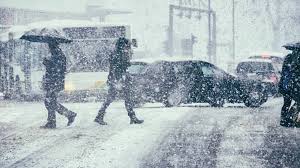Massive Winter Storm to Slam 12 States with Up to 48 Inches of Snow
A powerful winter storm is set to impact 12 states, prompting warnings and advisories across Washington, Colorado, Idaho, California, Utah, Nevada, Oregon, Montana, Wyoming, Minnesota, Alaska, and Michigan. Forecasters predict heavy snowfall and hazardous conditions, making travel dangerous in affected areas.
A powerful winter storm is sweeping across the United States, prompting officials to issue winter storm warnings and advisories in 12 states. The affected states include Washington, Colorado, Idaho, California, Utah, Nevada, Oregon, Montana, Wyoming, Minnesota, Alaska, and Michigan.
Forecasters warn that this storm could bring significant snowfall, with some areas expected to see heavy accumulations, potentially disrupting travel and daily activities. Hazardous conditions such as icy roads, reduced visibility, and strong winds could make driving treacherous and increase the risk of power outages in some regions.
Residents in these states are urged to take precautions, stay updated on weather alerts, and avoid unnecessary travel as the storm progresses. Authorities are also advising communities to prepare for potential disruptions and ensure they have essential supplies in case of prolonged severe weather.
The National Weather Service (NWS) has issued additional warnings about the severe cold and dangerous conditions accompanying the winter storm.

In Wyoming, forecasters cautioned that the extremely low temperatures pose a serious risk of frostbite and hypothermia, particularly for those with exposed skin. Without proper protection, frostbite could develop within minutes, making it crucial for residents to dress in multiple layers and limit time spent outdoors.
Meanwhile, in Alaska, the NWS warned that blizzard conditions could significantly reduce visibility, making travel extremely hazardous. In addition to heavy snowfall and strong winds, “dangerously” cold wind chills are expected, further increasing the risk of frostbite on exposed skin. These extreme conditions could make outdoor exposure life-threatening, and residents are urged to take precautions to stay safe and warm.
In the Pacific Northwest, winter storm warnings have been issued for several mountainous regions, with significant snowfall expected in higher elevations.
The warnings are in effect for the West Slopes of the North Cascades and surrounding areas, including Packwood and Stevens Pass. Forecasters predict snow accumulations ranging from 4 to 8 inches for locations situated above 3,000 feet. These conditions could make travel through mountain passes difficult, with snow-covered roads and reduced visibility posing hazards for drivers.
Similar warnings have been issued for the Upper Slopes of the Eastern Washington Cascades, as well as the Central and Southern Cascades of Oregon. In these areas, snowfall is expected to be even more substantial, with some locations potentially receiving up to 30 inches of snow. This heavy accumulation could increase the risk of avalanches, road closures, and travel disruptions. Residents and travelers are advised to monitor weather updates, use caution on the roads, and be prepared for rapidly changing conditions.
Winter storm warnings have been extended to Montana, Nevada, and California as a powerful system continues to bring heavy snowfall and hazardous conditions to the region.
Nevada
In Nevada, significant snow accumulations are expected, particularly in the Ruby Mountains and East Humboldt Range, where forecasters predict up to 27 inches of snow by Monday morning. The intense snowfall could lead to dangerous travel conditions, with snow-covered roads and limited visibility posing challenges for drivers.
California
Northern California is also bracing for a major winter impact, particularly in the Sierra Nevada, where heavy, wet snow is expected to accumulate. The combination of snowfall and strong winds may cause trees to collapse under the weight of the snow, increasing the risk of power outages. Residents are advised to prepare for potential disruptions and avoid unnecessary travel in affected areas.
Montana
Meanwhile, Montana is experiencing a mix of winter hazards. The Missoula and Bitterroot Valleys are under a Winter Storm Warning until 5 p.m. MST on Saturday, with a combination of snow squalls, ice, and mixed precipitation making travel extremely difficult. Forecasters warn that the Friday evening commute could be particularly treacherous, as icy roads and accumulating snow create nearly impossible driving conditions.
Looking ahead, a Winter Storm Watch has been issued for Montana from Sunday through Tuesday night, with the potential for up to 8 inches of snow. Residents should stay alert for further updates and prepare for ongoing winter weather impacts.
Oregon & Washington
Further west, hazardous conditions are also expected in the North Oregon Coast Range and South Washington Cascades. A Winter Storm Warning remains in effect until 4 a.m. PST on Sunday, with heavy snowfall anticipated. Areas above 2,500 feet could see between 8 to 14 inches of snow, while strong winds gusting up to 45 mph may lead to blowing snow and reduced visibility.
Authorities across all affected states are urging residents to exercise caution, stay updated on weather alerts, and prepare for possible travel disruptions and power outages as the storm continues to unfold.
Residents in the affected regions are strongly advised to avoid unnecessary travel as dangerous winter conditions continue to develop. However, for those who must be on the road, extreme caution is essential to ensure safety.
Authorities recommend that travelers be well-prepared by keeping a winter emergency kit in their vehicles. This kit should include essential supplies such as flashlights, extra batteries, non-perishable food, bottled water, blankets, warm clothing, and a first-aid kit. Additionally, having jumper cables, an ice scraper, a small shovel, sand or cat litter for traction, and a fully charged phone can be crucial in case of an emergency.
Before heading out, individuals should regularly check local weather forecasts and road conditions to stay informed about potential hazards such as snow-covered roads, black ice, and road closures. Travelers are also encouraged to allow extra time for their journeys, drive at reduced speeds, and maintain a safe distance from other vehicles to prevent accidents.
By taking these precautions and staying aware of changing conditions, residents can better protect themselves and their families during this severe winter storm.


Comments are closed, but trackbacks and pingbacks are open.